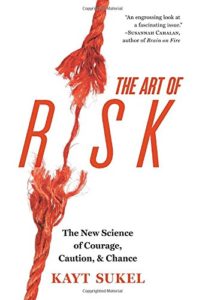Are you a risky person. Well if you take a lot of risks, those on the conservative side of the fence may see you as risky and unpredictable. If you succeed, you are a hero, if you fail, you are unreliable and fickle. The idea of ‘Risk’ has many such labels attached to it. But what is it that makes one person risk all and emerge victorious and others to repeatedly take similar risks and dig a hole for themselves. The Art of Risk takes a look at how we make decisions.
Is there always a way to quantify the risks involved in a decision and make the right choice? Or is there something else that makes people take risks when every rational indicator suggests otherwise. Kayt Sukel examines the idea of Risk and everything connected to it as she explains the anatomy (literally and figuratively) of risk.
Kayt sukel is a passionate traveler and science writer. Her work has appeared in the Atlantic Monthly, the New Scientist, USA Today, Pacific Standard, the Washington Post, ISLANDS, Parenting, the Bark, American Baby, and National Geographic Traveler.
 The Art of Risk: The New Science of Courage, Caution, and Chance
The Art of Risk: The New Science of Courage, Caution, and Chance
Hardcover: 288 pages
Publisher: National Geographic (March 1, 2016)
ISBN: 1426214723, 978-1426214721
Humans are largely considered rational. Our ability to go beyond the immediate stimulus and think is what separates us from the most in the animal kingdom. But in spite of this ability, many among us make decisions that cannot be labeled as rational. From our participation in extreme sports like mountain climbing to everyday mistakes like driving under influence or breaking the speed limit, we all succumb to the urges knowing the dangers involved.
What makes one person call a cab after a party and other to climb into their car and take the risk of getting caught, or more importantly injuring someone else? Are some of us biologically inclined to take more risks? What part does our circumstances and environment play in our appetite for risk? And above all, can we be trained to take calculated risks and come out as winners?
Kayt Sukel answers these and many more questions in The Art of Risk as she explores every variable that goes into the decision making process. The first part of the book explores the underlying brain physiology that is involved in a decision making process. She describes the specific parts of our brain in an easy-to-understand prose and unravels what happens in the milliseconds in which you decide to jump that red light.
She examines the big question: ‘Are some of us wired to be risk-takers?’ What part does genetics play in making one person more comfortable in taking risks over other? She discusses different genes and its variations that may play an important role in how you make decisions. But she also cautions that you cannot blame it all on your genes.
She then moves from the hardware to software, so to say, to look into the environmental effects, emotions, and stress. All of these play a crucial role in your decisions, right from your teen years all through your life. Peer pressures, social connections, and real or perceived stress of the situation can make you take decisions that you would not on another day.
Reading academic research can be boring. It is not a thrilling page turner nor a fantasy world of Harry Potter. Let’s face it, pouring over statistical data and inferences from research papers is no fun.In The Art of Risk Kayt Sukel compresses information from research done at various universities across the US and Europe as she evaluates each aspect of the decision making process. Narrating that with real world examples and interviews with people who take risk to earn their bread, the author makes understanding the subject matter easy.
Risks are unavoidable. Every moment we live and every decision we take is a risk. There is a risk in flipping a switch on, or stepping out and driving to the gas station round the corner. But the probability of a negative outcome in these cases is less, and we continue to do this every day without giving it a thought. In Part IV of the book, the author distills lessons learned from the information about the most important variables involved in assessing risks. She advises her readers on how to handle these variables and become better risk-takers and make decisions with positive outcomes.